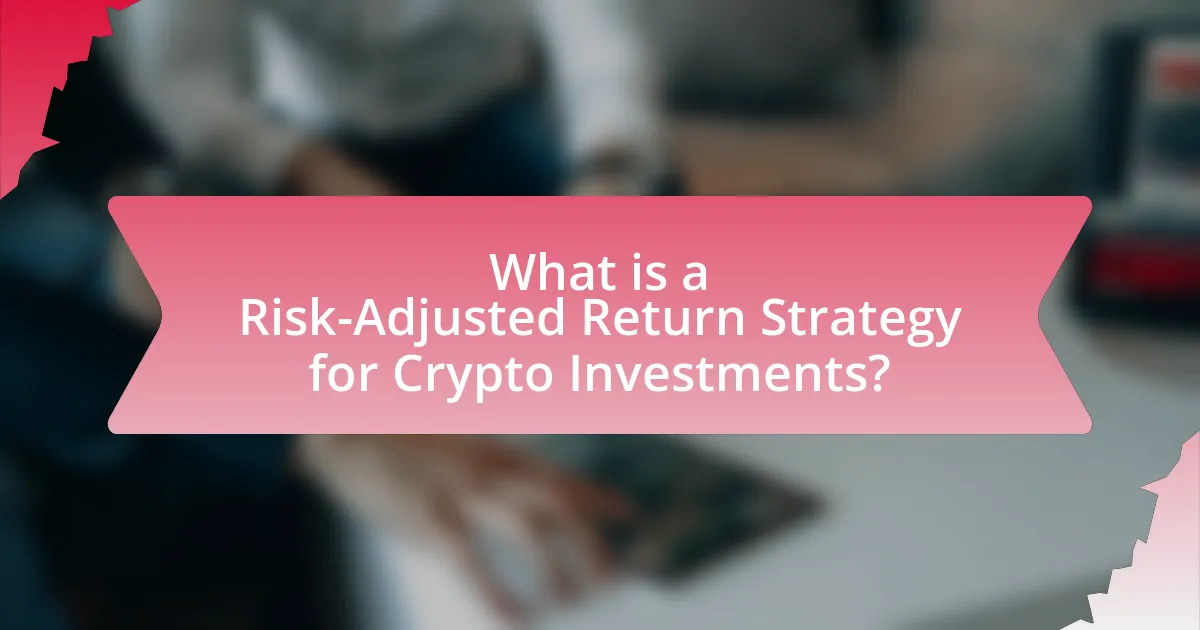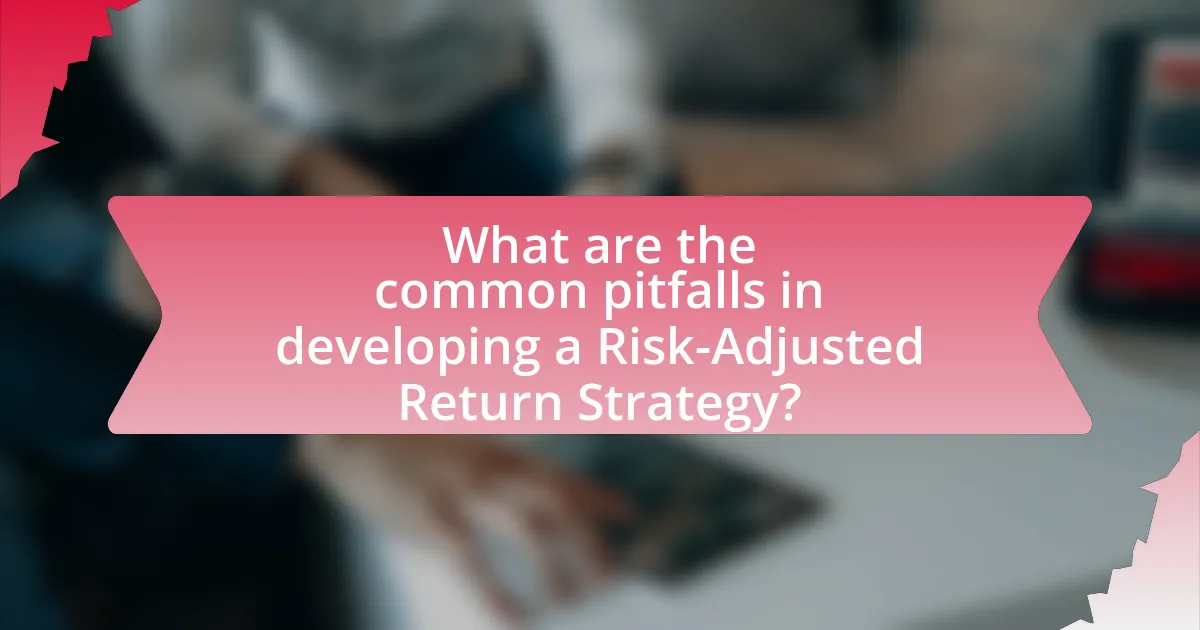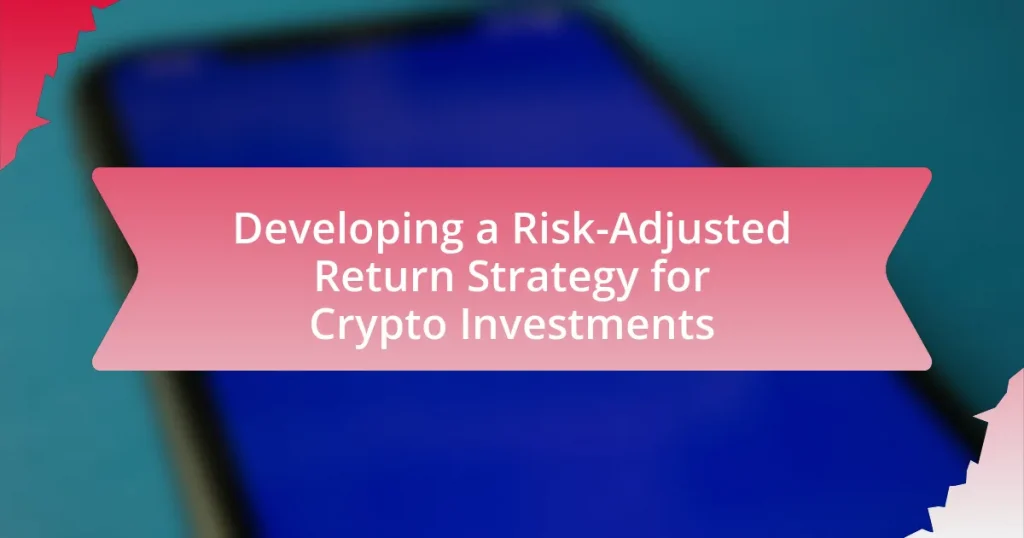A Risk-Adjusted Return Strategy for Crypto Investments is an investment approach that evaluates potential cryptocurrency returns while considering associated risks, utilizing metrics like the Sharpe Ratio. This strategy emphasizes the balance between returns and risks, distinguishing it from traditional investment methods that often overlook risk factors. Key components include risk assessment, return measurement, diversification, and performance evaluation, which collectively enhance portfolio stability and long-term growth. The article also explores the impact of market volatility, regulatory changes, and emotional biases on investment decisions, providing practical tips for implementing effective risk-adjusted strategies in the volatile crypto market.

What is a Risk-Adjusted Return Strategy for Crypto Investments?
A Risk-Adjusted Return Strategy for Crypto Investments is an investment approach that evaluates the potential returns of a cryptocurrency while considering the associated risks. This strategy utilizes metrics such as the Sharpe Ratio, which measures the excess return per unit of risk, to assess the performance of crypto assets relative to their volatility. By focusing on risk-adjusted returns, investors can make more informed decisions, balancing the high volatility typical of cryptocurrencies with the potential for significant gains. Historical data shows that applying risk-adjusted metrics can lead to better portfolio performance, as it encourages diversification and risk management, ultimately enhancing long-term investment outcomes.
How does a Risk-Adjusted Return Strategy differ from traditional investment strategies?
A Risk-Adjusted Return Strategy differs from traditional investment strategies by focusing on the balance between potential returns and the risks taken to achieve those returns. Traditional investment strategies often prioritize maximizing returns without adequately considering the associated risks, which can lead to significant losses during market downturns. In contrast, a Risk-Adjusted Return Strategy employs metrics such as the Sharpe ratio or Sortino ratio to evaluate performance relative to risk, ensuring that investors are compensated for the level of risk they assume. This approach is particularly relevant in volatile markets, such as cryptocurrencies, where price fluctuations can be extreme. By emphasizing risk management, a Risk-Adjusted Return Strategy aims to enhance overall portfolio stability and long-term growth, making it a more prudent choice for investors seeking sustainable returns.
What are the key components of a Risk-Adjusted Return Strategy?
The key components of a Risk-Adjusted Return Strategy include risk assessment, return measurement, diversification, and performance evaluation. Risk assessment involves identifying and quantifying potential risks associated with investments, such as market volatility and liquidity risks. Return measurement focuses on calculating returns in relation to the risks taken, often using metrics like the Sharpe ratio, which compares excess return to its standard deviation. Diversification aims to spread investments across various assets to mitigate risk, reducing the impact of any single asset’s poor performance. Performance evaluation involves regularly reviewing and adjusting the strategy based on changing market conditions and investment performance, ensuring alignment with risk tolerance and investment goals.
Why is risk adjustment crucial in the context of crypto investments?
Risk adjustment is crucial in the context of crypto investments because it allows investors to evaluate the potential returns relative to the risks involved. The cryptocurrency market is characterized by high volatility, with price fluctuations often exceeding 10% in a single day. By applying risk adjustment techniques, investors can better understand the risk-reward profile of their investments, enabling them to make informed decisions. For instance, a study by the CFA Institute highlights that incorporating risk metrics, such as the Sharpe ratio, can significantly enhance portfolio performance by aligning investment choices with individual risk tolerance levels. This approach not only aids in optimizing returns but also helps in mitigating potential losses in a highly unpredictable market.
What factors influence risk and return in crypto investments?
The factors that influence risk and return in crypto investments include market volatility, regulatory environment, technological advancements, and investor sentiment. Market volatility is significant, as cryptocurrencies often experience rapid price fluctuations; for instance, Bitcoin’s price dropped over 80% from its peak in 2017 to 2018, illustrating high risk. The regulatory environment also plays a crucial role; countries with strict regulations can limit market access, affecting returns. Technological advancements, such as improvements in blockchain technology, can enhance security and efficiency, potentially increasing returns. Lastly, investor sentiment, driven by news and social media, can lead to sudden price changes, as seen during the 2021 bull run when positive sentiment propelled prices to new highs.
How do market volatility and liquidity affect risk-adjusted returns?
Market volatility and liquidity significantly influence risk-adjusted returns by affecting the pricing and availability of assets. High market volatility often leads to greater price fluctuations, which can increase the potential for both higher returns and higher risks. For instance, during periods of high volatility, assets may experience rapid price changes, making it challenging to achieve stable risk-adjusted returns. Conversely, liquidity, defined as the ease with which an asset can be bought or sold without affecting its price, plays a crucial role in risk-adjusted returns. High liquidity typically allows for quicker transactions and less price impact, enabling investors to enter and exit positions more efficiently, thereby stabilizing returns. Research indicates that assets with higher liquidity tend to exhibit lower volatility, which can enhance risk-adjusted returns by reducing the likelihood of significant losses during market downturns. Therefore, both market volatility and liquidity are critical factors in shaping the risk-return profile of crypto investments.
What role do regulatory changes play in shaping risk profiles?
Regulatory changes significantly influence risk profiles by altering the legal and operational landscape within which financial entities operate. These changes can introduce new compliance requirements, affect market access, and modify the risk assessment frameworks that organizations use to evaluate their exposure to various assets, including cryptocurrencies. For instance, the implementation of the European Union’s Markets in Crypto-Assets Regulation (MiCA) aims to provide a comprehensive regulatory framework that enhances investor protection and market integrity, thereby reducing the perceived risks associated with crypto investments. Such regulations can lead to increased transparency and accountability, which in turn can stabilize market conditions and influence investor confidence.
What methodologies can be used to develop a Risk-Adjusted Return Strategy?
To develop a Risk-Adjusted Return Strategy, methodologies such as the Sharpe Ratio, Sortino Ratio, and Value at Risk (VaR) can be employed. The Sharpe Ratio measures the excess return per unit of risk, providing a clear metric for comparing different investments. The Sortino Ratio refines this by focusing only on downside risk, making it particularly useful for assessing investments with asymmetric return distributions, common in crypto markets. Value at Risk quantifies the potential loss in value of an asset or portfolio under normal market conditions over a set time period, allowing investors to understand the risk exposure. These methodologies are validated by their widespread use in financial analysis and portfolio management, demonstrating their effectiveness in optimizing returns while managing risk.
How can historical data analysis inform risk assessment?
Historical data analysis can inform risk assessment by identifying patterns and trends that indicate potential future risks. By examining past price movements, volatility, and market behaviors in cryptocurrencies, analysts can quantify risks associated with specific investment strategies. For instance, a study by Baur and Dimpfl (2018) found that historical price data can reveal correlations between cryptocurrencies and traditional assets, helping investors understand how market conditions may affect their portfolios. This analysis enables the development of models that predict risk exposure based on historical performance, thereby enhancing decision-making in crypto investments.
What are the advantages of using quantitative models in strategy development?
Quantitative models provide several advantages in strategy development, particularly in the context of developing a risk-adjusted return strategy for crypto investments. Firstly, these models enable data-driven decision-making by analyzing large datasets to identify patterns and trends, which enhances predictive accuracy. For instance, a study by Chen et al. (2020) demonstrated that quantitative models could improve investment performance by up to 15% compared to traditional methods by utilizing historical price data and market indicators.
Secondly, quantitative models facilitate the assessment of risk through statistical measures, allowing investors to optimize their portfolios based on risk tolerance. Research by Black and Litterman (1992) highlights that quantitative approaches can effectively balance expected returns against potential risks, leading to more informed investment choices.
Lastly, these models allow for backtesting strategies against historical data, providing insights into their potential effectiveness before implementation. A report from the CFA Institute indicates that backtesting can reveal the robustness of a strategy, thereby increasing investor confidence in the chosen approach.
How can investors implement a Risk-Adjusted Return Strategy in practice?
Investors can implement a Risk-Adjusted Return Strategy by utilizing metrics such as the Sharpe Ratio, which measures the excess return per unit of risk. By calculating the Sharpe Ratio for various crypto assets, investors can compare their risk-adjusted performance and select those that offer the best return relative to their risk. Historical data shows that portfolios with higher Sharpe Ratios tend to outperform in volatile markets, as evidenced by a study from the Journal of Portfolio Management, which found that assets with a Sharpe Ratio above 1.0 generally indicate favorable risk-adjusted returns. Additionally, diversifying investments across different cryptocurrencies can further enhance risk-adjusted returns by mitigating the impact of individual asset volatility.
What tools and platforms are available for monitoring crypto investments?
Tools and platforms available for monitoring crypto investments include CoinMarketCap, CoinGecko, and Blockfolio. CoinMarketCap provides real-time price tracking, market capitalization data, and historical charts for thousands of cryptocurrencies, making it a comprehensive resource for investors. CoinGecko offers similar features, including community insights and liquidity data, which help investors gauge market sentiment. Blockfolio, now known as FTX App, allows users to track their portfolio performance and receive price alerts, enhancing investment management. These platforms are widely used in the crypto community, evidenced by their high traffic and user engagement metrics, confirming their reliability for monitoring investments.
How can diversification enhance risk-adjusted returns?
Diversification enhances risk-adjusted returns by spreading investments across various assets, which reduces the overall risk of the portfolio. When investors allocate their capital among different cryptocurrencies, the negative performance of one asset can be offset by the positive performance of another, leading to more stable returns. Research by Markowitz (1952) in the Modern Portfolio Theory demonstrates that a diversified portfolio can achieve a higher return for the same level of risk compared to a concentrated portfolio. This principle is particularly relevant in the volatile crypto market, where individual assets can experience significant price fluctuations. By diversifying, investors can improve their risk-adjusted returns, as evidenced by studies showing that diversified portfolios tend to outperform non-diversified ones over time.

What are the common pitfalls in developing a Risk-Adjusted Return Strategy?
Common pitfalls in developing a Risk-Adjusted Return Strategy include over-reliance on historical data, inadequate risk assessment, and failure to account for market volatility. Over-reliance on historical data can lead to misleading expectations, as past performance does not guarantee future results, particularly in the volatile crypto market. Inadequate risk assessment often results from not considering all potential risks, including regulatory changes and technological vulnerabilities, which can significantly impact returns. Additionally, failure to account for market volatility can lead to mispricing of risk, as crypto assets often experience extreme price fluctuations that traditional models may not adequately capture. These pitfalls can undermine the effectiveness of a Risk-Adjusted Return Strategy, leading to suboptimal investment decisions.
What mistakes do investors often make when assessing risk?
Investors often make the mistake of underestimating the volatility of cryptocurrencies when assessing risk. This underestimation can lead to inadequate risk management strategies, resulting in significant financial losses. For instance, historical data shows that Bitcoin has experienced price fluctuations exceeding 80% from peak to trough, highlighting the inherent volatility in the crypto market. Additionally, investors frequently fail to consider the impact of external factors, such as regulatory changes or technological advancements, which can drastically alter market conditions. By neglecting these aspects, investors may misjudge the potential risks associated with their crypto investments.
How can overconfidence lead to poor investment decisions?
Overconfidence can lead to poor investment decisions by causing investors to overestimate their knowledge and abilities, resulting in excessive risk-taking. This cognitive bias often leads individuals to ignore critical market data and trends, believing they can predict outcomes better than they actually can. Research indicates that overconfident investors tend to trade more frequently, which can increase transaction costs and reduce overall returns. For instance, a study by Barber and Odean (2000) found that overconfident investors underperformed the market by an average of 3.8% annually due to their excessive trading behavior. This demonstrates that overconfidence not only distorts risk perception but also negatively impacts investment performance.
What are the dangers of ignoring market trends and signals?
Ignoring market trends and signals can lead to significant financial losses and missed opportunities in crypto investments. When investors disregard these indicators, they may fail to recognize shifts in market sentiment, which can result in poor timing for buying or selling assets. For instance, a study by the CFA Institute found that investors who react to market signals can achieve returns that are 2-3% higher annually compared to those who do not. Additionally, ignoring trends can lead to overexposure to volatile assets, increasing the risk of substantial losses during market downturns. Historical data shows that during the 2018 crypto market crash, many investors who failed to heed warning signals experienced losses exceeding 80% of their investments. Therefore, neglecting market trends and signals can severely undermine investment performance and increase risk exposure.
How can emotional biases impact investment strategies?
Emotional biases can significantly distort investment strategies by leading to irrational decision-making. For instance, biases such as overconfidence can cause investors to underestimate risks and overestimate their ability to predict market movements, resulting in poor investment choices. Research by Barber and Odean (2001) found that overconfident investors traded more frequently and achieved lower returns compared to their less confident counterparts. Additionally, loss aversion, a common emotional bias, can lead investors to hold onto losing investments longer than advisable, hoping for a rebound, which can further exacerbate losses. This behavior is supported by Kahneman and Tversky’s Prospect Theory, which illustrates how individuals tend to prefer avoiding losses over acquiring equivalent gains. Thus, emotional biases can undermine rational investment strategies, leading to suboptimal financial outcomes.
What strategies can mitigate the effects of emotional decision-making?
To mitigate the effects of emotional decision-making, investors can implement structured decision-making frameworks, such as the use of predefined investment criteria and rules. These frameworks help to create a systematic approach to investing, reducing the influence of emotions by relying on objective data and analysis. For instance, employing a stop-loss strategy can limit potential losses and prevent impulsive reactions to market fluctuations. Research indicates that investors who adhere to a disciplined investment strategy are less likely to make emotionally driven decisions, leading to improved long-term performance. Additionally, maintaining a diversified portfolio can reduce the emotional impact of individual asset volatility, as the overall risk is spread across various investments.
How can investors maintain discipline in volatile markets?
Investors can maintain discipline in volatile markets by adhering to a well-defined investment strategy and sticking to predetermined risk management rules. This approach helps mitigate emotional decision-making, which can lead to impulsive actions during market fluctuations. For instance, research from the CFA Institute indicates that investors who follow a disciplined investment plan are less likely to make detrimental decisions based on short-term market movements. By setting clear goals, diversifying their portfolios, and regularly reviewing their investment strategies, investors can remain focused on long-term objectives rather than reacting to immediate market volatility.

What best practices should be followed for effective Risk-Adjusted Return Strategies?
Effective Risk-Adjusted Return Strategies should incorporate diversification, rigorous risk assessment, and continuous performance evaluation. Diversification across various cryptocurrencies mitigates the impact of volatility in any single asset, as evidenced by studies showing that a diversified portfolio can reduce risk without sacrificing returns. Rigorous risk assessment involves using metrics such as the Sharpe ratio and Value at Risk (VaR) to quantify potential losses and adjust investment strategies accordingly. Continuous performance evaluation ensures that strategies remain aligned with market conditions and investor goals, with research indicating that regular rebalancing can enhance returns while managing risk effectively.
How can continuous learning and adaptation improve investment outcomes?
Continuous learning and adaptation can significantly improve investment outcomes by enabling investors to respond effectively to market changes and emerging trends. Investors who engage in ongoing education and analysis can refine their strategies based on real-time data, historical performance, and evolving market conditions. For instance, a study by the CFA Institute found that investors who regularly update their knowledge and adapt their strategies based on new information tend to achieve higher returns compared to those who rely on outdated methods. This adaptability allows investors to mitigate risks and capitalize on opportunities, ultimately leading to more favorable investment results.
What resources are available for staying updated on crypto market trends?
To stay updated on crypto market trends, utilize resources such as cryptocurrency news websites, social media platforms, and market analysis tools. Websites like CoinDesk and CoinTelegraph provide timely news and analysis, while platforms like Twitter and Reddit offer real-time discussions and insights from the crypto community. Additionally, tools like CoinMarketCap and TradingView allow users to track price movements and market data, facilitating informed investment decisions. These resources collectively enhance understanding of market dynamics and trends, essential for developing a risk-adjusted return strategy in crypto investments.
How can networking with other investors enhance strategy development?
Networking with other investors enhances strategy development by facilitating the exchange of diverse insights and experiences. Engaging with a variety of investors allows individuals to gain different perspectives on market trends, risk management, and investment opportunities, which can lead to more informed decision-making. For instance, a study by the CFA Institute highlights that collaboration among investors can improve portfolio performance by leveraging collective knowledge and strategies. This collaborative approach not only broadens understanding but also fosters innovative thinking, ultimately leading to more robust and adaptable investment strategies in the volatile crypto market.
What practical tips can help investors optimize their Risk-Adjusted Return Strategy?
Investors can optimize their Risk-Adjusted Return Strategy by diversifying their portfolio across various cryptocurrencies and asset classes. Diversification reduces the impact of volatility in any single asset, thereby improving the overall risk-adjusted return. For instance, a study by the CFA Institute found that a diversified portfolio can enhance returns while minimizing risk, as it spreads exposure across different market conditions. Additionally, employing risk management techniques such as setting stop-loss orders and regularly rebalancing the portfolio can further enhance risk-adjusted returns by protecting against significant losses and maintaining desired asset allocation.
How should investors regularly review and adjust their strategies?
Investors should regularly review and adjust their strategies by conducting systematic performance evaluations and market analyses. This involves assessing the returns of their investments against benchmarks and adjusting their portfolios based on changes in market conditions, risk tolerance, and investment goals. For instance, a study by the CFA Institute indicates that regular portfolio reviews can enhance investment performance by allowing investors to respond proactively to market volatility and emerging trends. Additionally, utilizing tools such as performance metrics and risk assessment models can provide concrete data to inform necessary adjustments, ensuring that strategies remain aligned with the investor’s objectives and the evolving landscape of crypto investments.
What role does setting clear investment goals play in strategy success?
Setting clear investment goals is crucial for strategy success as it provides direction and measurable objectives for investors. By defining specific targets, such as desired returns or risk tolerance, investors can align their strategies with their financial aspirations. Research indicates that investors with clear goals are more likely to make informed decisions and maintain discipline during market fluctuations, ultimately leading to better performance. For instance, a study by the CFA Institute found that goal-oriented investors tend to exhibit lower emotional decision-making, which enhances their overall investment outcomes.















